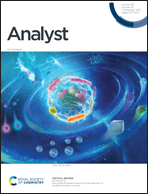A water-soluble conjugated polyelectrolyte for selective and sensitive detection of carcinogenic chromium(vi)†
Abstract
Environmental water pollution caused by hexavalent chromium (Cr(VI)) is a threat to living beings due to its carcinogenic nature. Herein, we report the synthesis of a highly fluorescent water-soluble conjugated polyelectrolyte PPMI and its application as a fluorescence sensor to monitor traces of carcinogenic Cr(VI) ions in water. PPMI was synthesized via the oxidative polymerization method followed by post-polymer functionalization. Fluorescent PPMI exhibited a photoluminescence quantum yield of 23.87 and displayed a rapid, very selective, and sensitive turn-off fluorescence signal in response to Cr(VI), with a significantly high quenching constant of 1.32 × 106 M−1. The mechanism of sensing was found to be static quenching. The limit of detection of this highly accessible analytical method was found to be in nanomolar ranges, i.e. 0.85 nM. Additionally, sensing on solid platforms such as economical paper strips was successfully achieved, which is very challenging and highly recommended for any reliable, portable, and economical analytical method.



 Please wait while we load your content...
Please wait while we load your content...